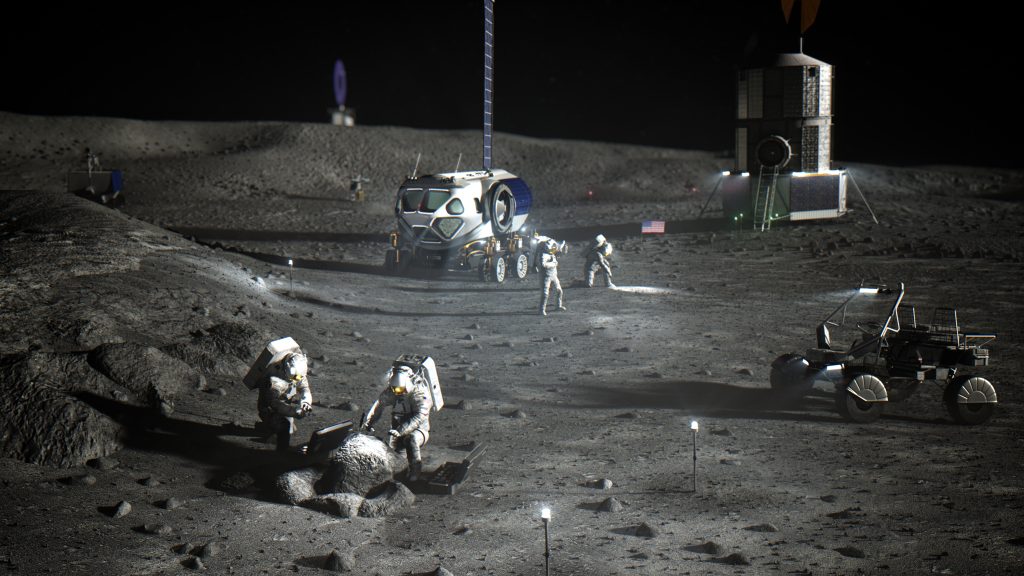It’s only natural to look at the Moon and wonder what it would be like to live there. Thanks to Buzz Aldrin who landed there in 1969, we know it’s a magnificent desolation. Even before the Apollo missions science fiction writers and scientists knew how desolate the place was.
But, as far back as the late 19th Century, they also saw it as a natural outpost. So did NASA, the former Soviet Union, and their respective militaries. And, that led to people on both sides drawing up elaborate plans for Moon bases.
Likely these were for strategic uses, but there were also positive scientific reasons to build these outposts. A recent historical treatise published in Acta Aeronautica looked at some of those plans. The ideas behind them, particularly on the U.
S. side, were pretty strong. Planners wanted to show the U.
S. was absolutely capable of creating the technology to get to the Moon first. The Military Gets Involved in Lunar Bases After it was created in 1958, NASA set out to design lunar bases.
There were already some interesting proposals floating around the space exploration sector from the U. S. Air Force and the Army.
The Air Force’s idea was Project LUMAN in 1958. It comprised a three-part aim of getting military astronauts on the Moon by 1964. The first step was called Man In Space Soonest (MISS).
The idea was to get people into space, preferably before the Soviets did. Once the U. S.
accomplished that, the plan was to implement LUREC (Lunar Reconnaissance). That would send an orbiter to the Moon. Then, the Manned Lunar Landing and Return phase would start up and eventually put people on the Moon by the 1964 deadline.
Interestingly, Neil Armstrong figured prominently as part of the group of astronauts who would be involved. But, the program as described by the Air Force got canceled and came back to life as Project Mercury. As we all know, Armstrong eventually did fly to space and become the first person to set foot on the Moon.
Neil Armstrong on the Moon in 1969. Credit: NASA Not to be left out of the Moon race, the U. S.
Army came up with Project Horizon. It was a 1959 feasibility study for a lunar military base. German-U.
S. rocket man Wernher von Braun was part of the short-lived project. He went on to be the first director at NASA, and the ideas in the Army study lived on in Project Apollo.
That included the development of the Saturn V rocket that took The project led to the development of the Saturn I7 which evolved into the eventual Saturn V. Bombing the Moon, Looking for Water, and Lunar Mining Probably one of the more bizarre ideas (that thankfully didn’t materialize) was a secret plan from the Air Force to send a nuclear bomb to the Moon and set it off. The planners had what they suggested were good scientific grounding for such an experiment but, it literally didn’t fly.
Mission planners who weren’t planning to nuke the Moon did come up with good plans for long-term habitation. They designed living modules that would be buried under the lunar regolith. The underground cities would protect the lunar visitors from radiation, meteorite bombardment, and other surface hazards.
In addition, the mission teams thought long and hard about utilizing natural resources to extract water, oxygen, and other materials for use by the inhabitants. Much of that In-situ Resource Utilization (ISRU) is part of modern-day mission planning not just for future lunar bases. Mars mission infrastructure benefits from it, too.
Many early ideas about lunar mining form part of what NASA hopes will be lunar bases within the decade and Mars habitats in the far future. Still Looking to the Moon The history of lunar base mission planning contains many more projects that never made it past the drawing boards in their original form. But, they weren’t totally discarded.
They are a reflection of a period in history when the “best and brightest” in two countries faced challenges as they looked toward space. Nearly 55 years have passed since Neil Armstrong first walked on the Moon. The mission plans he followed may have been born in the first half of the 20th Century, but they set the groundwork for the Apollo missions and beyond.
And, the ideas in those plans still echo through to modern scenarios. Today, we watch the Artemis program slowly make its way through huge challenges, and the Gateway project take shape. New generations of planners are involved: scientists, astronauts, engineers, and others create new and improved lunar settlement plans.
And, they aren’t just U. S. plans.
China has its eye set on eventual human settlements, for example. Underlying all those scenarios are some of the basic principles first set out by 20th Century planners and well-informed science fiction writers who brought the idea of lunar bases to the public. The dream of lunar bases is still alive.
Reflections on early lunar base design – From sketch to the first moon landing Man in Space Soonest The post NASA had Been Designing Lunar Bases for Decades Before Armstrong First Set Foot on the Moon appeared first on Universe Today. .
From: universetoday
URL: https://www.universetoday.com/157979/nasa-had-been-designing-lunar-bases-for-decades-before-armstrong-first-set-foot-on-the-moon/



